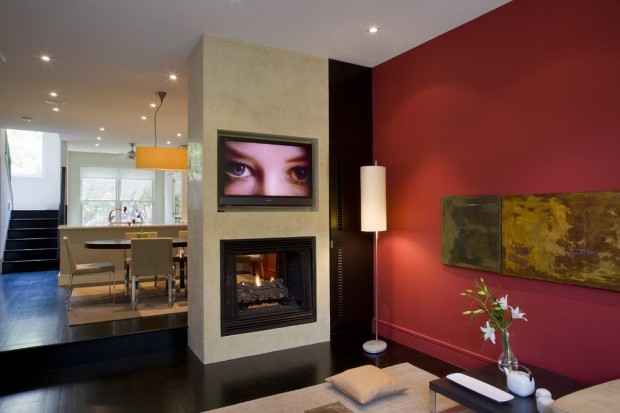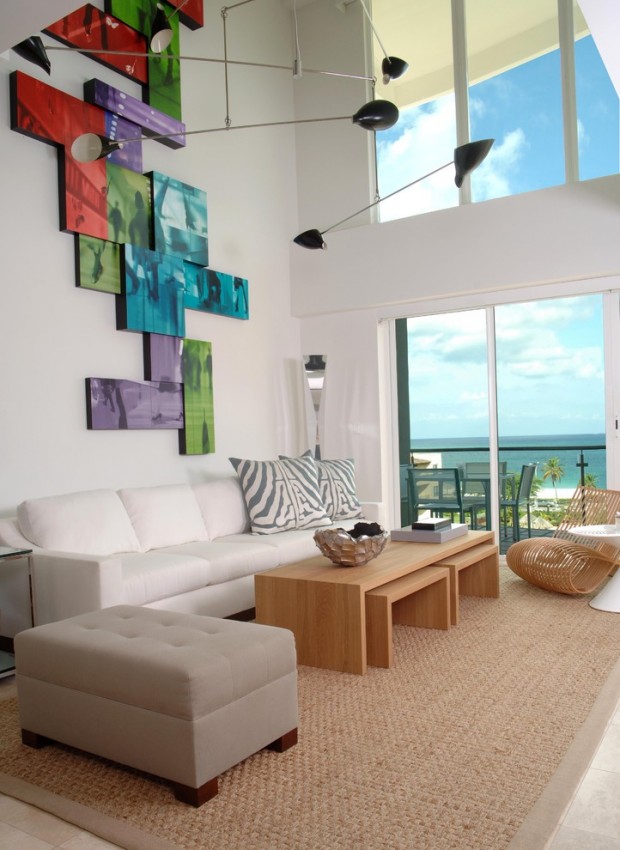Choosing the right wall colour involves much more than looking through swatches. One must consider the colour of the floor, elements in the room, and the ability to change the room’s theme in the future. Picking the perfect paint requires more than just colour preference. Choose wisely after reading the following.
Remember the Floors
Consider a three-dimensional diagram of your room. You have to mind the look of the new wall as well as how well it complements other elements and dimensions of the room, including the floor.
Depending on the colour of the floor, choose a neutral wall colour or one with pizzazz. Complement floor colour or take focus away from the floor with a bold wall colour. Those with creativity have fun with complementary colours (Make the wall red and floors black to create a chess or checkerboard theme.)

Image by FORMA Design via Houzz
Lead with Art
Choosing a wall colour first is a mistake. Align pieces of wall art and identify a common palette or hue. Voila! You’ve let your wall art choose the overall colour of the room and wall.
To further the art-into-reality theme, get crafty with frames and match wall moulding and door trimming. Make the room a living piece of art by emulating the appearance of a framed picture. Let the room’s decor and colours copy an artist’s vision.

Image by poggi design via Houzz
Match the Furniture
As with floors, match wall colour with other room implements including sofas, chairs, and coffee tables. Buy matching fabric upholstery or complementary throw pillows. Purchase blankets that match the wall to cover tables and drapes for the windows that work well with the room’s palette.
Blend with the Environment
A bright colour like yellow appears out of place in a small cabin or cramped apartment. Such environments look better with bold and intense colours. Use the environment and construction of the room to choose a colour. Metal posts or beams, resembling train parts and tracks inspire a railroad theme replete with charcoal walls and metal chairs and tables.
Get Vertical
Decorators use splashes of colour throughout the room yet pay attention to vertical placement. Darker shades are devoted to the floor, medium tones for eye level, and lighter shades for above eye level. The vertical element dictates placement of wall ornaments and decor throughout the room.
Image by Jane Lockhart Interior Design via Houzz
Work in Tile
Tile backsplashes are popular in bathrooms and kitchens, yet works in every room of the home. If you’re undecided about choosing one colour, feature a range of colours with a backsplash. Do-it-yourself or hire a tile specialist or artist to form a pattern, figure, or form letters on the wall (Feature the names of family members.)
Image by Blackwell Architecture Inc. via Houzz
Get Help
Don’t be shy and ask for help from an interior designer or hardware store employee regarding paint and decor. Two heads and opinions are better than one when it comes to design. You may think a colour is wonderful and learn you’re the only one. Conversely, a particular shade might be your third or fourth choice yet popular with others.
Image source
Rent the Colour
‘Rent’ a particular shade for a few weeks and survey how you and others feel. There’s no alternative for putting the paint on the wall and the opportunity to try different colours. Others paint sections of the wall and live among several selections to help make a final decision. Regardless of how many temporary colours used, putting something on the wall helps visualize and determine whether a shade is something to live with or do without.
Use Primer
You don’t have to use paint primer but it makes a huge difference regarding final application. You can find ways to cut corners when it comes to the price of the paint but don’t dismiss necessary steps to save time or money. Watch home painting videos and ask for additional labour help if needed. Once primer is applied around the wall’s edges with a brush, use a roller to cover the wall. Don’t worry about streaks.
Image source
Author Bio
Dakota Kirkwood is always looking for better ways to update his old home. When he finds something that works, he likes to sit down and share it with others online. You can read his helpful posts on a variety of blogs and websites.
